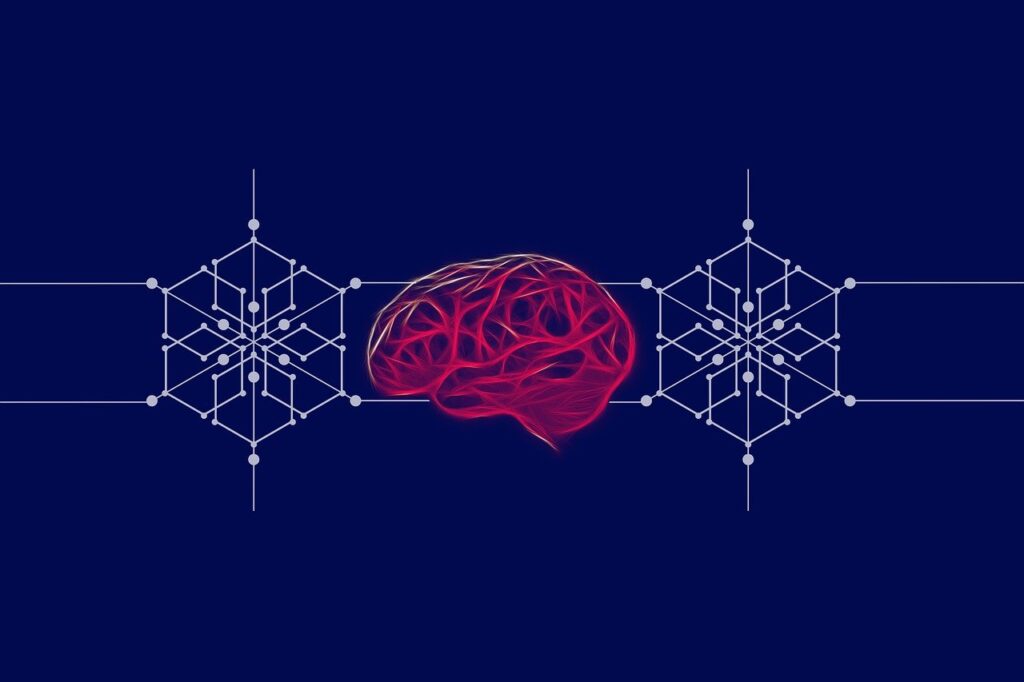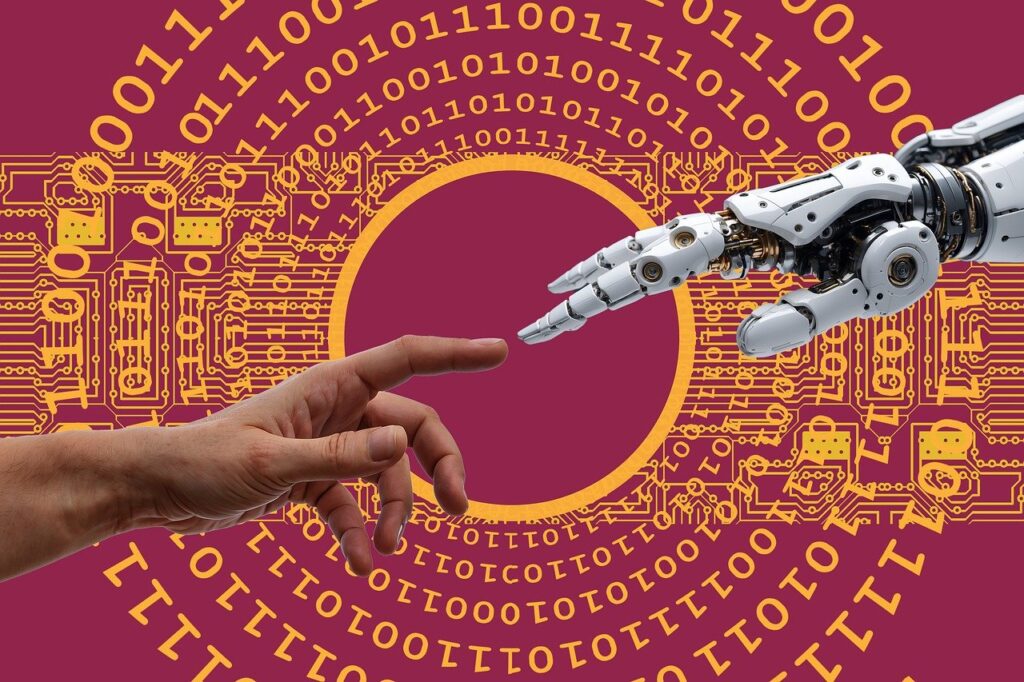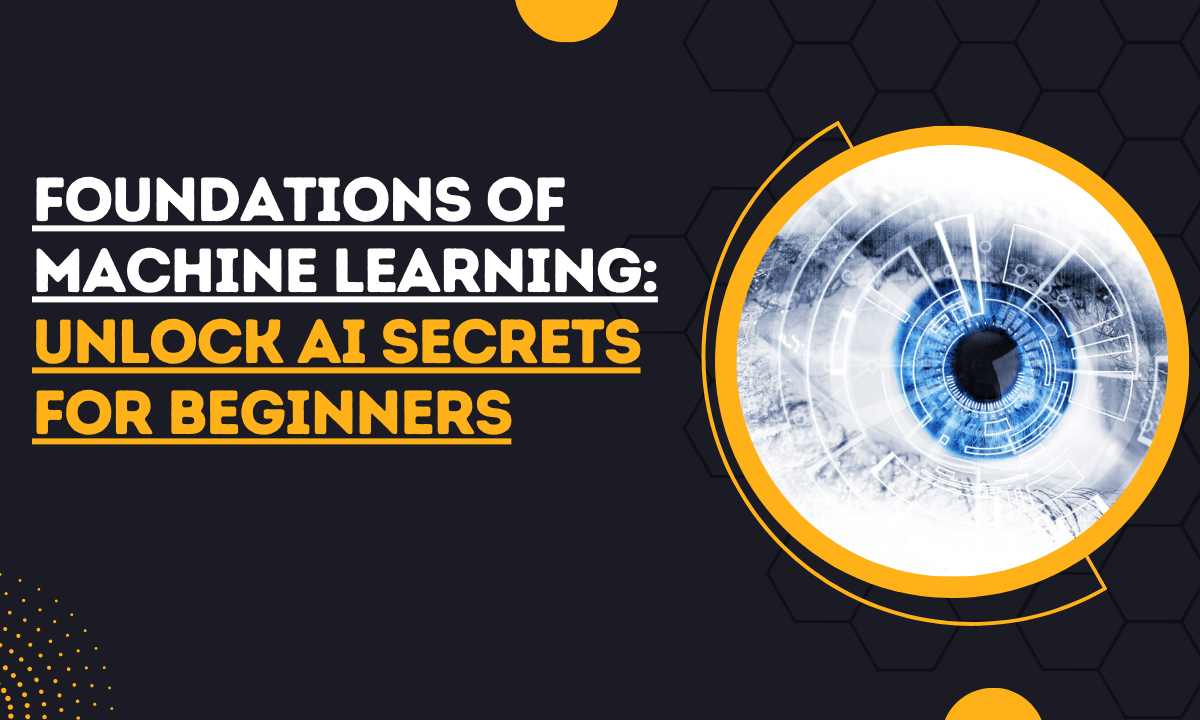Foundations of Machine Learning: Unlock AI Secrets for Beginners
This article discusses the foundations of machine learning to lay the groundwork for exploring AI technologies. Interestingly, it also aims to show how AI technology is built and applied to solve real-world problems.
According to studies recent the global artificial intelligence market is projected to grow to $299.64 billion by 2026, with an impressive compound annual growth rate (CAGR) of 35.6% from 2021 to 2026.
In today’s world, machine learning stands at the core of technology, from the personalized recommendations we see online to breakthroughs in medicine and autonomous vehicles.
This article works as a beginners’ guide. It offers an accessible, hands-on look into the basics of machine learning—its algorithms, applications, and transformative potential.
Also, regardless of whether you’re a beginner or just curious, mastering these foundations will give you a front-row seat to the future.
1.1 What is Machine Learning?
Machine Learning (ML) is a field of artificial intelligence (AI) that enables systems to learn and improve from experience without explicit programming.
In simple terms, understanding the foundations of machine learning (ML) is all about how it empowers computers to process and analyze large amounts of data.
We also see how machines recognize patterns, and make decisions based on insights gained, leading to smarter systems that adapt over time.
1.2 Why Machine Learning Matters
Machine learning drives innovation across numerous industries.
One of the foundations of machine learning is its ability to process complex data quickly. This makes it indispensable for tasks like image recognition, natural language processing, and predictive analytics.
From filtering spam in our emails to recommending movies and assisting in complex medical diagnoses, ML is reshaping our daily lives and work.

1.3 Real-World Applications
Machine learning applications span a vast range of fields:
- Healthcare: Predictive models assist doctors in diagnosing diseases and personalizing treatments.
- Finance: Fraud detection and stock market prediction are enhanced by ML algorithms.
- Retail: Personalized shopping experiences and efficient supply chain management are optimized by ML.
2. Basic Concepts of Machine Learning
2.1 Supervised, Unsupervised, and Reinforcement Learning
Understanding the three main types of machine learning is key for any beginner:
- Supervised Learning: In this approach, models learn from labeled data, where the correct answer is provided for each example. Examples include classification and regression.
- Unsupervised Learning: This involves learning from unlabeled data, helping find hidden patterns and groupings, often used in clustering.
- Reinforcement Learning: Here, models learn through trial and error, receiving rewards or penalties. This is commonly applied in robotics and gaming.
2.2 Key Terminologies in ML
Some fundamental ML terms include:
- Dataset: A collection of data used to train and evaluate the model.
- Feature: Individual measurable properties of the data.
- Model: An algorithm trained to make predictions or decisions.
- Training: The process of teaching the model using data.
3. How Machine Learning Works
3.1 Data Collection and Preparation
Data is the backbone of any ML model. Gathering accurate and relevant data and cleaning it by handling missing values, outliers, and inconsistencies is essential.
This phase often requires significant effort but is critical for creating an effective model.
3.2 Choosing the Right Algorithm
Selecting an algorithm depends on the type of problem being solved (classification, regression, clustering, etc.), the size of the data, and the computational resources available.
Popular algorithms include decision trees, neural networks, and clustering algorithms.
3.3 Model Training
Model training involves feeding the algorithm data and adjusting it based on feedback to optimize its performance. This stage is crucial, as it determines how well the model will generalize to new data.
4. Types of Machine Learning Algorithms
4.1 Supervised Learning Algorithms
Supervised Learning is a way that computers learn by example, using something called “labeled data.” This means each example given to the computer already has the correct answer attached, like a teacher marking answers on a test.
The computer uses these labeled examples to learn patterns, helping it make predictions in new situations.

For instance, supervised learning is used for tasks like classification (telling if an email is spam or not) and regression (predicting prices of things like houses).
This type of learning is like studying from a key to solve future problems!
Supervised learning uses labeled data, meaning each data point has a correct output.
Examples of supervised learning algorithms include linear regression, decision trees, and support vector machines (SVMs).
4.2 Unsupervised Learning Algorithms
Unsupervised learning is a type of machine learning where the computer looks for patterns or hidden structures in data without being told what to look for. This is important for the foundations of machine learning.
It doesn’t need labels or outcomes to guide it.
Two common techniques used in unsupervised learning are clustering, where similar things are grouped together, and association.
Here the computer finds relationships between different things. For example, it might group similar animals together based on their features or link items that are often bought together in a store.
4.3 Reinforcement Learning Algorithms
In reinforcement learning, a computer program learns by trying things out and getting feedback.It makes decisions and then finds out if it did well or not based on rewards or penalties.
Think of it like a video game: if the program does something good, it gets a reward (like points), but if it makes a mistake, it gets a penalty (like losing points).
This kind of learning is used in robots and AI to help them get better at tasks, like playing games or doing jobs on their own.
5. Supervised Learning Algorithms Explained
5.1 Linear Regression
Linear regression predicts continuous outcomes by establishing a relationship between independent and dependent variables.
For example, predicting housing prices based on factors like location, size, and age.
5.2 Logistic Regression
Despite its name, logistic regression is used for classification tasks, such as spam detection or predicting binary outcomes like “yes” or “no.”
5.3 Decision Trees
Decision trees are used for classification and regression. They split data into branches to make predictions, making them easy to interpret and visualize.
5.4 Support Vector Machines (SVMs)
SVMs are powerful classifiers that find the best decision boundary between different classes of data. They’re often used in image recognition and text classification.
6. Unsupervised Learning Algorithms Explained
6.1 Clustering Algorithms
Clustering algorithms, like K-means, are used to group things that are similar.
For example, imagine you have a big box of toys, and you want to sort them into different groups like action figures, dolls, and cars. K-means helps by looking at the toys and automatically putting them into the right groups.
This is useful for things like understanding customer preferences or making images smaller so they can be stored easily.
6.2 Dimensionality Reduction
Dimensionality reduction is a way to make big data easier to understand by simplifying it.
Sometimes, data has too many features, like a picture with millions of tiny details.
Techniques like Principal Component Analysis (PCA) and t-SNE help reduce the number of features without losing important information, making the data easier to look at and work with.
It’s like taking a big puzzle and simplifying it so it’s easier to solve.
6.3 Association Rule Learning
Association rule learning helps find hidden patterns in big data by looking at how different things are connected. For example, in a grocery store, it might find that people who buy bread often also buy butter.
This is useful for understanding customer behavior or improving sales.
For instance, by discovering which items frequently go together, we can use that information to make smarter decisions, such as placing those items next to each other in the store.
7. Reinforcement Learning Algorithms Explained
7.1 Q-Learning
Q-learning is a type of machine learning where an agent (like a robot or game character) learns how to make the best decisions by getting rewards or penalties from its actions.
It explores an environment, takes actions, and then receives feedback in the form of rewards.
Over time, the agent learns which actions lead to the highest rewards and uses that knowledge to make better choices, like teaching a robot to find its way through a maze.
7.2 Deep Q-Networks (DQN)
Deep Q-Networks (DQN) take the idea of Q-learning and improve it by using neural networks.
These networks help the agent learn from very complex situations, like playing video games with lots of moving parts.
Instead of just keeping track of simple rewards, DQN helps the agent predict the best action by looking at patterns in the data, making it better at learning in difficult environments.
7.3 Policy Gradient Methods
Policy gradient methods are a way for an agent to directly learn the best actions to take in different situations.
Instead of relying on rewards to guess the best action, as in Q-learning, policy gradient methods improve by gradually adjusting their strategy, or “policy,” over time.
This approach becomes particularly beneficial when dealing with complex problems, such as controlling a robot’s movement in a fast-paced environment, where quick decisions are essential.
As a result, it allows the agent to continually refine its actions, ensuring better performance even in dynamic and unpredictable situations.
8. Neural Networks and Deep Learning
8.1 Introduction to Neural Networks
Neural networks mimic the human brain, with interconnected layers of nodes (neurons) that learn to recognize patterns.
A neural network is a machine learning model that makes decisions by simulating how the human brain functions. It mimics the way biological neurons collaborate to recognize patterns, evaluate possibilities, and draw conclusions.
These networks form the foundation of deep learning.
8.2 Basics of Deep Learning
Deep learning uses multi-layered neural networks, often trained on vast datasets, making it ideal for complex problems like image and speech recognition.
8.3 Applications of Deep Learning
Deep learning powers technologies like facial recognition, language translation, and self-driving cars, proving its versatility and potential.
9. Evaluation of Machine Learning Models
9.1 Metrics for Classification Models
Classification metrics like accuracy, precision, recall, and F1 score measure how well a model performs in categorizing data correctly.
9.2 Metrics for Regression Models
Regression metrics such as Mean Absolute Error (MAE) and Root Mean Squared Error (RMSE) assess how close predictions are to actual outcomes.
9.3 Confusion Matrix Explained
A confusion matrix shows a model’s performance across multiple classes, displaying the true positives, false positives, and other outcomes in a structured format.
10. Data Processing and Feature Engineering
10.1 Data Cleaning
Data cleaning involves fixing errors, handling missing values, and removing duplicates. Clean data is crucial for accurate model training.
10.2 Feature Selection
Feature selection identifies the most important variables, streamlining the model and improving performance.
10.3 Feature Scaling and Normalization
Scaling and normalization ensure data values are consistent, improving the model’s efficiency and convergence during training.
FAQs
- What is the best algorithm to start with?
- Beginners can start with linear regression, which is simple to implement and understand.
- How is AI different from ML?
- AI is a broader concept of creating intelligent machines, while ML is a subset of AI focused on enabling systems to learn from data.
- What industries are using ML the most?
- ML is widely used in healthcare, finance, retail, and automotive industries.
- Can a beginner learn ML without coding?
- While coding enhances learning, there are beginner-friendly tools with visual interfaces for non-coders to experiment with ML.
- How long does it take to learn ML?
- Learning ML basics takes a few months, but mastering it can take years, depending on the depth and career goals.
- What is the role of data in ML?
- Data is fundamental in ML. This is one of the importnat foundations of machine learning. In fact, high-quality data leads to better model accuracy and performance.
Related Posts
Natural Language Processing (NLP) for Smarter Search Intent
The Power of AI Content: Transforming the Digital World
Skyrocket Your Reach with AI-Driven Search Optimization!
Conclusion
The foundations of machine learning are essential for understanding how algorithms and data can work together to solve real-world problems.
First, we explore basic concepts like supervised, unsupervised, and reinforcement learning. Next, we dive into algorithms like Q-learning and deep learning to understand how machines make decisions.
As machine learning continues to evolve, its applications in fields like healthcare, finance, and technology grow increasingly impactful.
Ultimately, mastering the foundations of machine learning empowers us to leverage AI in creating innovative solutions for the future

